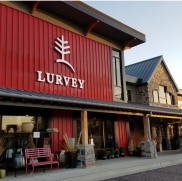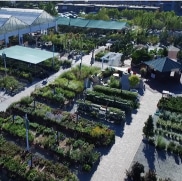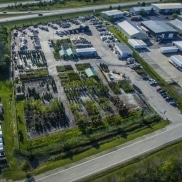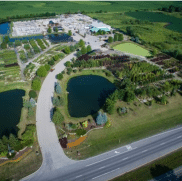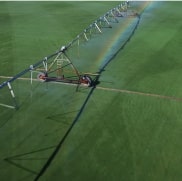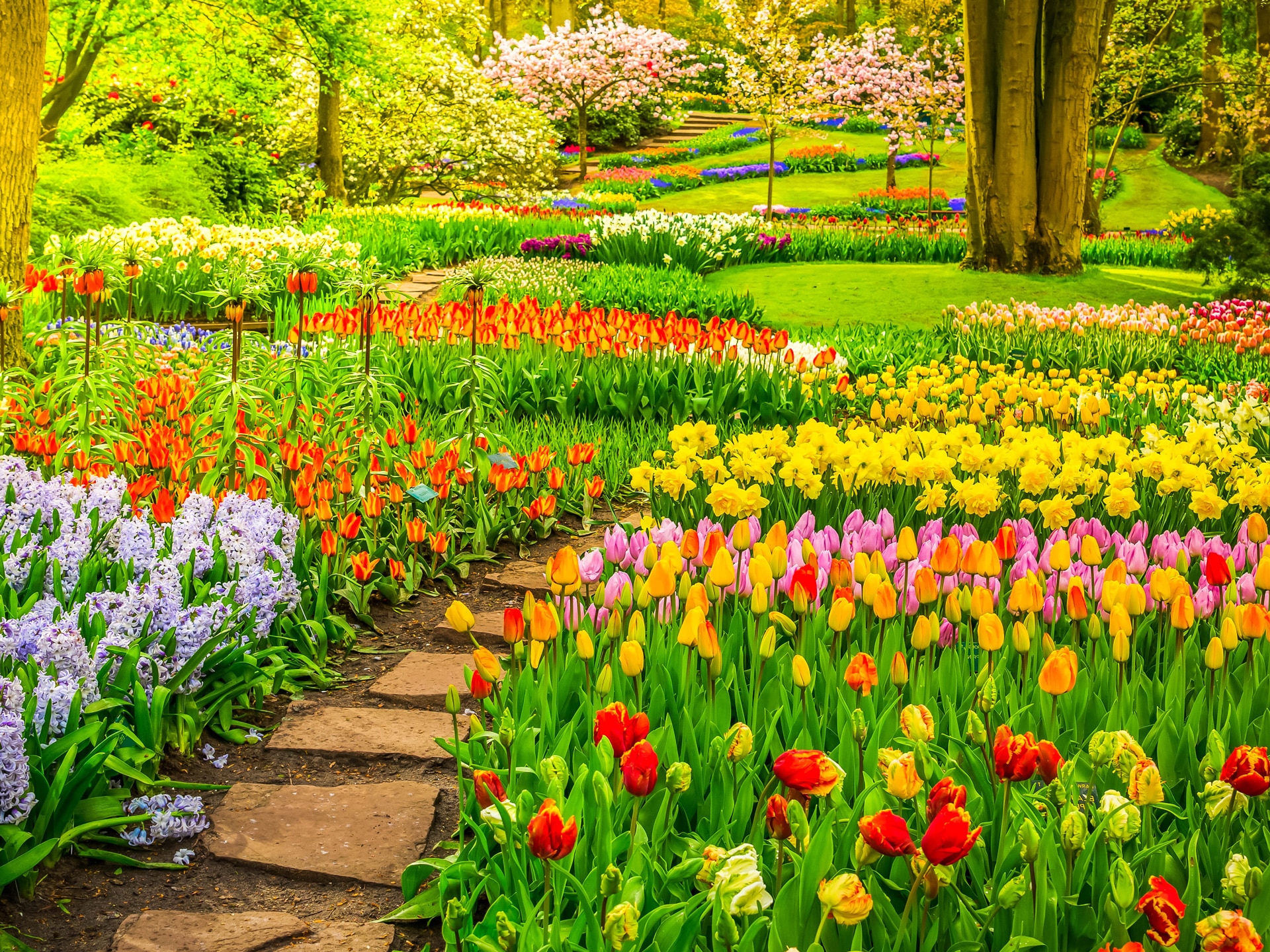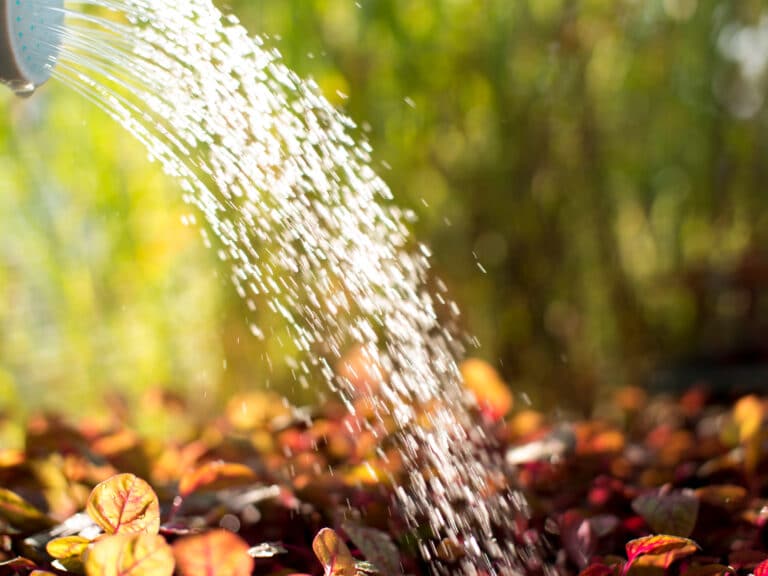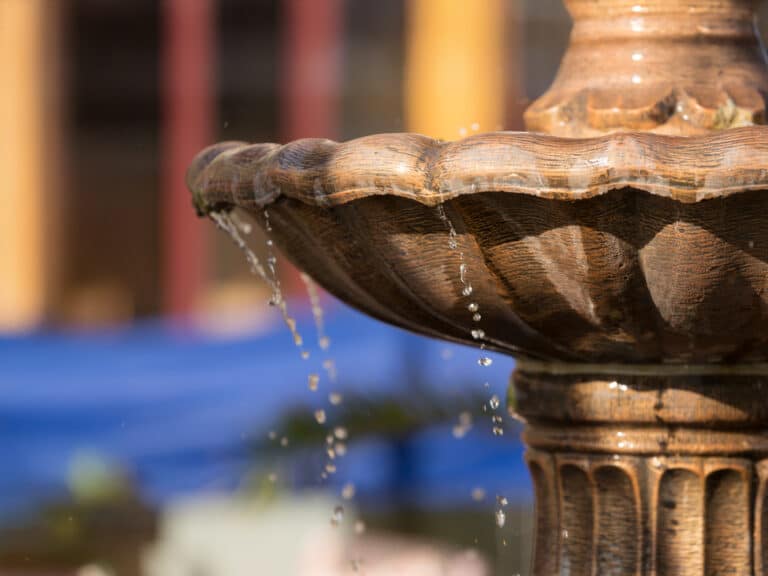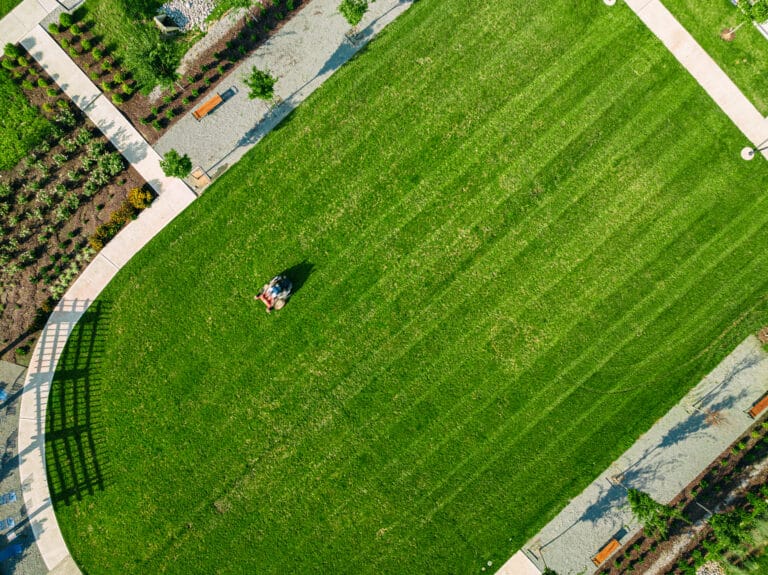What makes spring flowering bulbs so special? They are simply the earliest spring color in the garden. Spring bulbs deliver early color and fragrance at a time when most other plants in the garden are still asleep. These early-season plants require relatively low maintenance, attract and feed pollinators, and offer a reliable pop of color that melts the winter blues away.
Which Spring Flowering Bulbs Are For You?
No matter what your garden style is, there are a variety of spring flowering bulb options to complement and enhance your outdoor space. Spring flowering bulbs offer a stunning array of colors, textures, and sizes, transforming gardens into vibrant displays. These bulbs cater to every aesthetic preference from the delicate pastel hues of crocus and hyacinths to the bold, fiery oranges of tulips. Spring flowering bulb textures vary from smooth petals to ruffled edges, adding depth and interest to any garden. The size range is equally impressive, with tiny crocus nestled among towering imperial fritillaries, creating a harmonious and visually appealing composition. After learning about these stunning spring plants don’t forget to explore all of the available options by visiting the Fall Seasonal category on our website!
Tulips
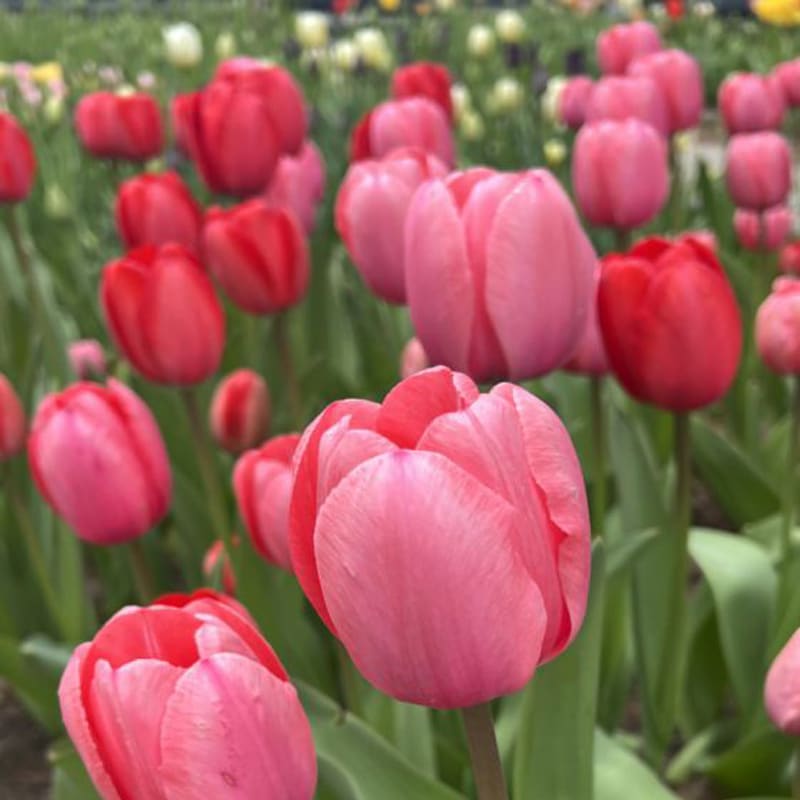
Their vibrant, cup-shaped blooms bring a splash of color after winter’s dormancy. Their wide variety of hues and patterns, from bold reds and yellows to soft pastels, makes them versatile and eye-catching. Tulips also stand out for their ability to create striking displays in garden beds or containers, signaling the arrival of spring with their elegant, upright form.
Daffodils
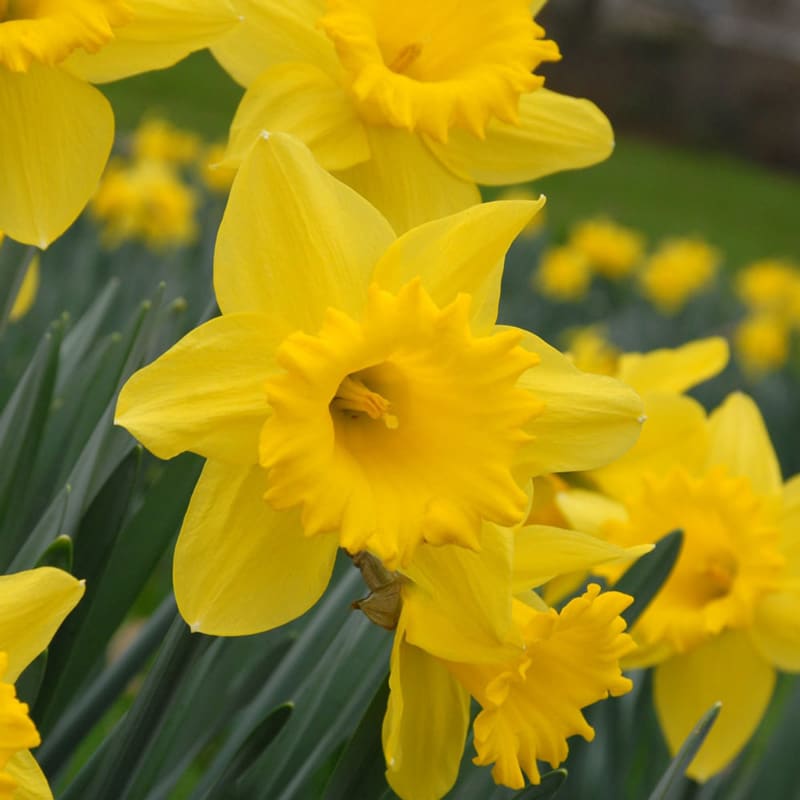
Known for their stunning yellow blooms, daffodils brighten the landscape after the long winter months. Their resilience allows them to thrive in cool temperatures, often being among the first flowers to bloom in spring. With their distinctive trumpet-shaped flowers, daffodils symbolize renewal and bring a cheerful touch to any garden setting.
Hyacinths
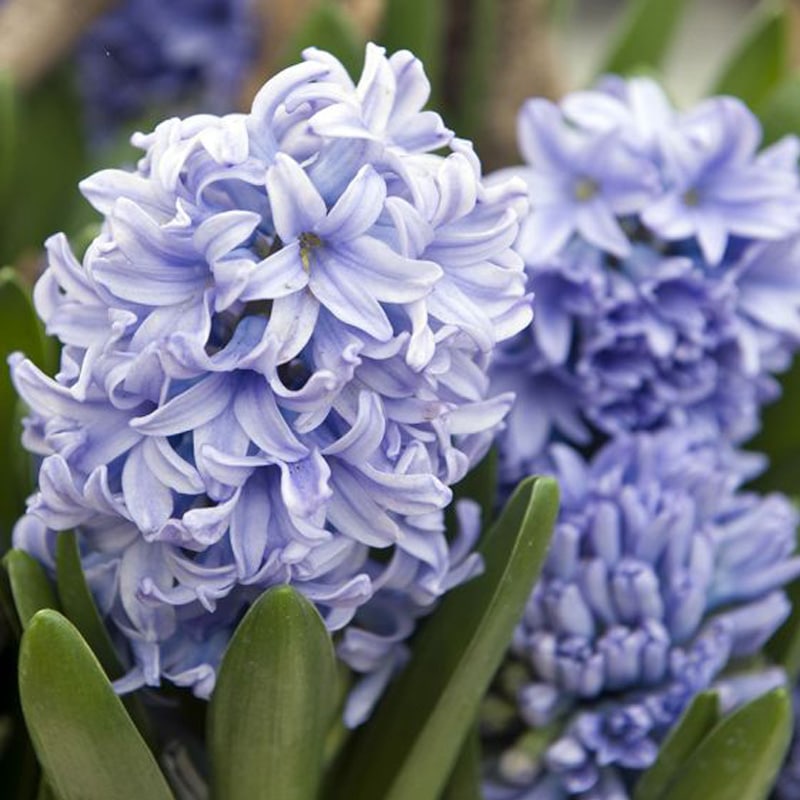
Filling the air with their sweet fragrance, the intoxicating scent, often described as similar to grape hyacinths, adds a delightful experience to the garden. Hyacinths are also incredibly versatile and can be grown in pots, containers, or directly in the ground, making them adaptable to garden spaces large and small.
Lurvey Pro Tip – Hyacinth bulbs irritate most people’s skin. Be sure to wear gloves when handling these bulbs!
Crocus
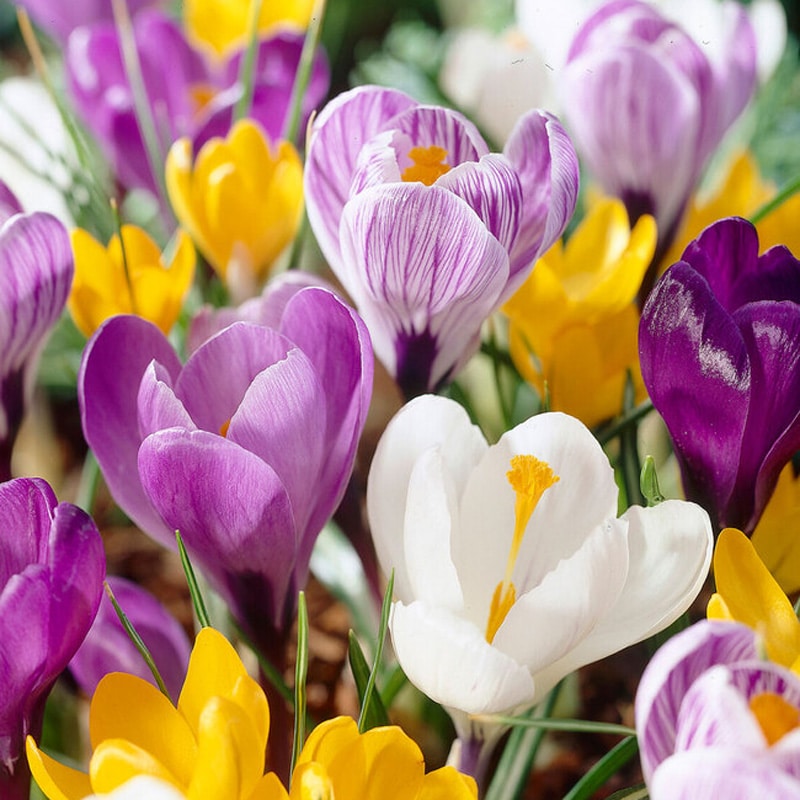
Another bulb that emerges early in the garden, crocus flowers stand out from the bulb crowd. They often emerge from the still snow-covered ground to announce the arrival of spring. Compact and low-growing, crocus is a great choice for naturalizing in gardens and lawns.
Muscari
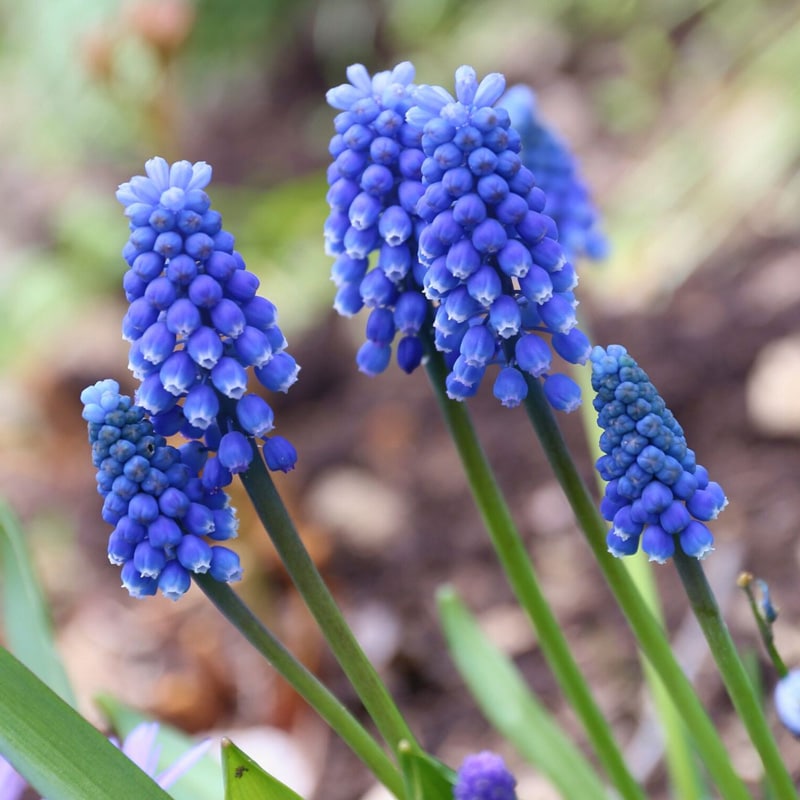
Muscari are distinct from other flowering bulbs due to their dense clusters of tiny, bell-shaped blooms that resemble miniature grapes. Their deep blue to violet hues create a striking contrast in spring gardens. Unlike many bulbs, muscari has a compact growth habit and spreads easily. This makes it ideal for mass plantings or naturalizing in borders and pathways.
Allium
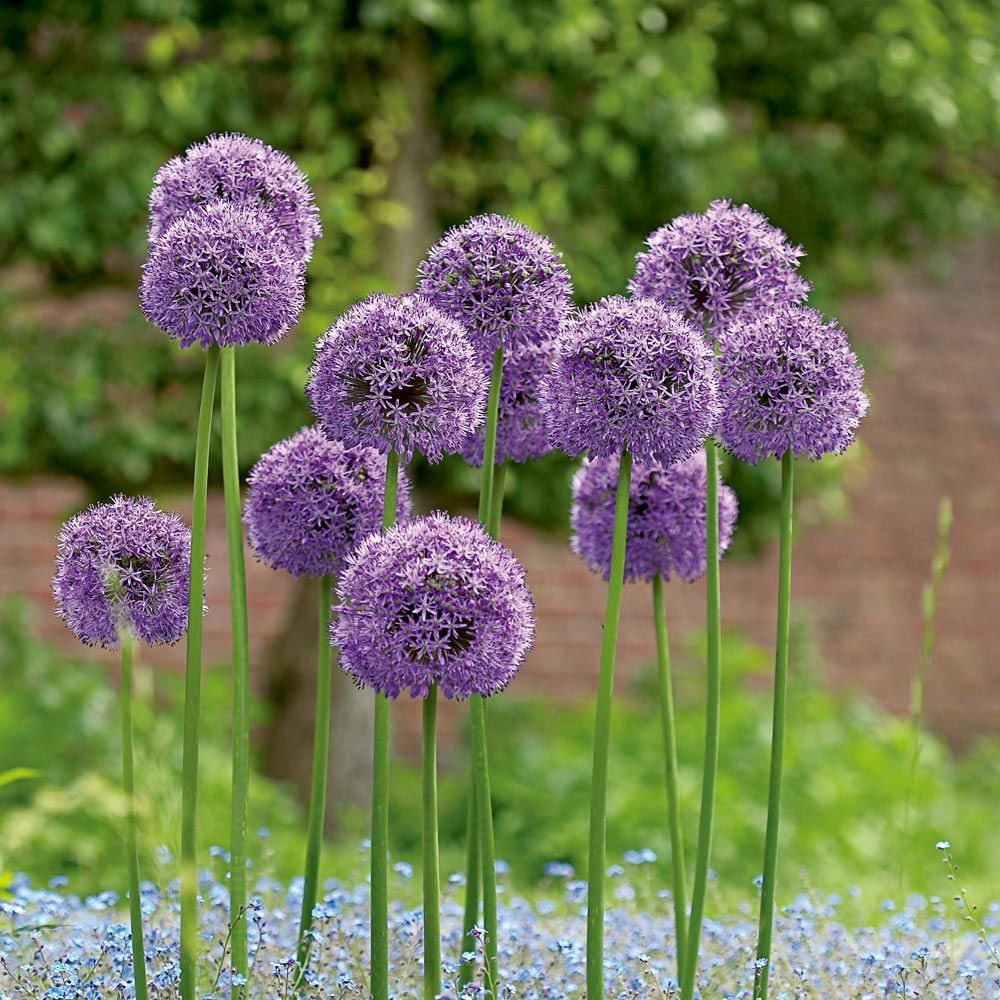
Featuring a truly striking flower comprised of globe-like clusters of small flowers that form large, spherical heads, allium is a must-have for any gardener. Often referred to as ornamental onion, allium can grow in a wide range of conditions and produces its flowers on tall, sturdy stems.
Lurvey Pro Tip – If you’re in an area that’s prone to deer damage you may want to consider that when choosing the bulbs for your garden. Crocus, Hyacinth, and Muscari are good choices to consider.
Only Premium Flowering Bulbs
At Lurvey, we only source premium spring flowering bulbs from trusted partners like Proven Winners, Netherland Bulb, and Simple Pleasures. This ensures you receive healthy, high-quality bulbs that will thrive in your garden. These bulbs are often larger, more vigorous, and more likely to bloom profusely. Additionally, our trusted sources provide bulbs that have been inspected for diseases and pests, minimizing the risk to your garden.
Planting Spring Flowering Bulbs
To enjoy bulb flowers that bloom in spring – tulips, daffodils, hyacinths, crocus, etcetera, you must plant in the fall. Spring bulbs require a “dormant” period of 10 to 14 weeks of cold temperatures to stimulate root development and growth. Cold temperatures are considered to be 35-45 degrees Fahrenheit. You can plant as soon as bulbs become available, typically in early to mid-September, but must finish before the first hard freeze in December. If you have to store them, keep them dry and cool, somewhere between 50 and 60 degrees.
Choosing Where to Plant
Most bulbs grow fine in full or partial sun locations but need good drainage. Bulbs will rot in gardens that have standing water or areas that flood. Remember while bulbs might be short-lived, the draw is their beautiful flowers. These plants will need sunlight to generate the energy needed to put on a stunning display of color.
Lurvey Pro Tip – Planting among the roots of perennials, trees, and shrubs is a great option since the bulbs come up before perennials or shrubs leaf out.
It can be difficult to dig a hole among existing roots, but using a bulb planter or power auger will make individual holes easier to dig. This will also minimize damage to existing roots. For larger bed plantings digging a trench or excavating the entire bed area instead of digging individual holes can save a lot of time and energy.
How Many Bulbs Do I Need?
Once you’ve chosen the bulb varieties you like and where you want to plant them, you’ll need to figure out how many bulbs those areas will need. It’s not complicated but some of us might have to remove the cobwebs from our mathematical brain section. Here are the four steps you need to follow to determine how many of each bulb you need.
1. Measure
Measure the garden spaces that you intend to plant. Break the area into separate shapes for complex spaces to simplify the measurements and calculation.
2. Calculate
Find the area of the garden sections that you want to plant. If you’ve forgotten your grade school math, like we did, review the examples below!

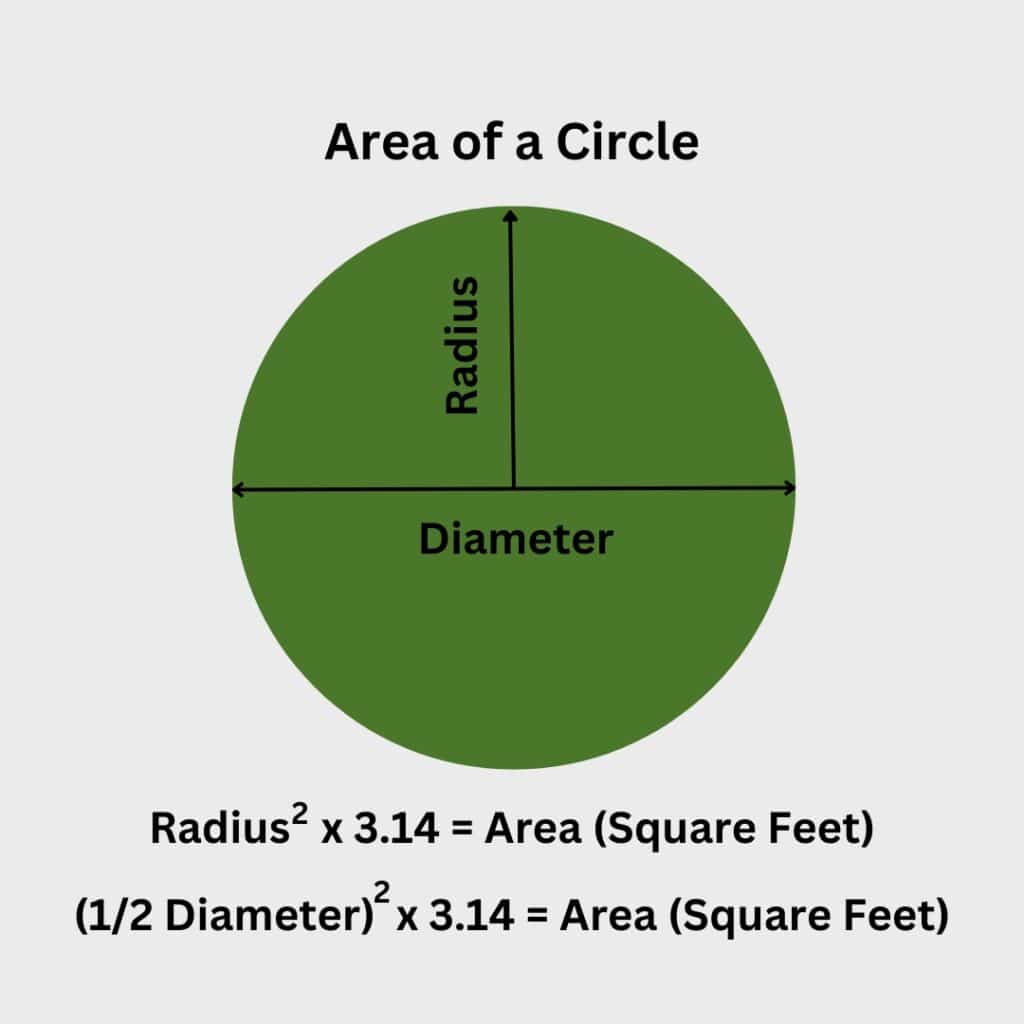
3. Determine Bulb Coverage
Refer to the coverage chart below to determine how many bulbs of a particular variety are needed per square foot.
| Bulb Variety | Number of Bulbs Per Square Foot | Bulb Variety | Number of Bulbs Per Square Foot |
|---|---|---|---|
| Allium (Large) | 2 | Eranthis | 15 |
| Allium (Miniature) | 15 | Fritillaria | 2 |
| Anemone | 15 | Fritillaria (Miniature) | 8 |
| Botanical Crocus | 15 | Galanthus | 20 |
| Botanical Iris | 15 | Hyacinths | 5 |
| Camassia | 5 | Leucojum | 7 |
| Chionodoxa | 10 | Muscari | 15 |
| Crocus | 15 | Scilla | 15 |
| Daffodils | 3-4 | Scilla hycinthoides | 15 |
| Daffodils (Miniature) | 6 | Tulips | 6 |
| Dutch Iris | 8 | Tulips (Miniature) | 9 |
to add more bulbs per square foot, possibly even doubling the amount.
4. Put It All Together
To determine the total number of bulbs needed to complete your design, you’ll need the area from all the spaces you measured. Combine that with the bulbs per square foot of the various varieties from the chart above to determine how many of each bulb variety to purchase.
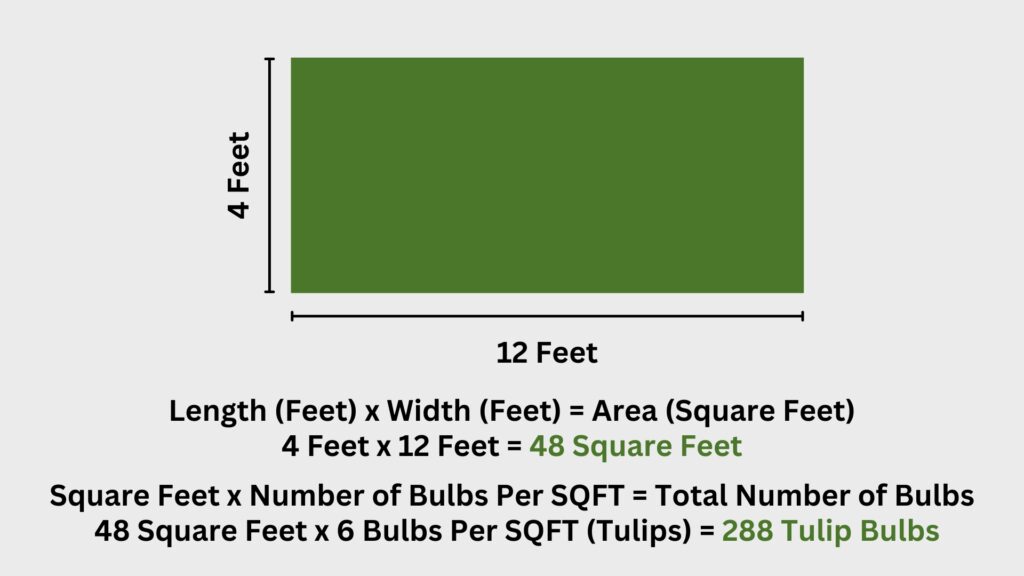
Now that you know how many bulbs it’s time to visit us! We are stocked with the bulbs, hand tools, and fertilizer you will need to create your stunning bulb display for next spring. If you have any questions along the way our specialists are ready to give you the answers you’re looking for.
Plant Now for Spring Flower Color
You have your bulbs and you’re ready to plant, great! To determine how deep to plant, consider the diameter or size of the bulb. A good rule of thumb is to plant your bulb three times as deep as the diameter of the bulb. For example, if a tulip bulb is 2” in diameter, then the planting depth should be approximately 6”.
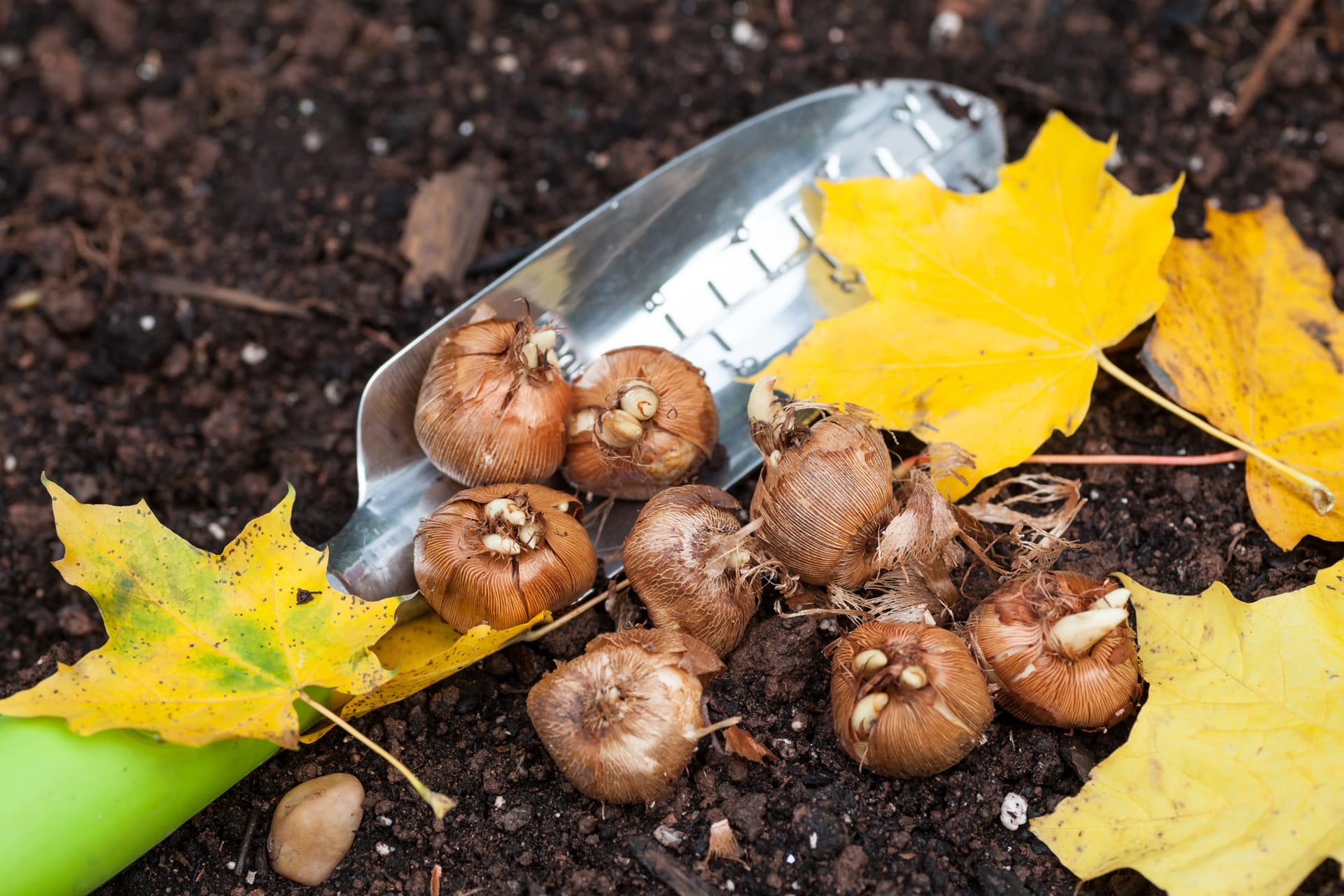
Lurvey Pro Tip – Now is the perfect time to mix in some compost or peat moss to improve drainage and soil structure.
Place and do not push the bulb into the soil, pointed side up. If you’re not sure which end is right, it’s ok, bulbs will typically come up if planted upside down or sideways. Cover with soil and water the bulbs in, if the soil is dry. Add 2-3” of mulch for protection from critters and winter’s freezing and thawing. If squirrels are an issue, consider adding chicken wire but remember to remove it in spring.
Bulbs can also be planted in containers, but you will still need to follow planting depth guides. Use a light potting mix, water after planting, and keep moist. Place the container in a protected spot away from the sun and freezing temperatures, and keep it in a shed or garage to protect the bulbs from squirrels. You can do one variety of bulbs or choose a mixture. Place tulips at the bottom, then a layer of soil, hyacinth in the middle, then another layer of soil, and crocus on top for a variety.
Spring Flowering Bulb Care
Bulbs are relatively low maintenance and can be left alone for years. They multiply on their own by producing more bulbs, especially daffodils, crocus, anemones, and grape hyacinths. Tulips and hyacinths gradually become exhausted and bulbs must be planted to fill holes back in. Here are a couple of other ways you can ensure that your bulbs continue to bloom for years to come.
Fertilizer
Bulbs already have all the energy they need to grow in the first season. The addition of compost will improve soil structure and add organic matter. Espoma Bulb Tone or Bone Meal will help to provide additional energy in the following years.
Watering
Typically spring rains are sufficient for bulbs but if there is an unusually dry spring, make sure to lend a helping hand. Start watering when the flower buds first appear and remember that shallow watering will not do the job. Remember that you may have planted these bulbs 6-8” below the ground and the water needs to soak to that depth.
Do I Need to Dead-head My Bulbs?
Tulips and other flowers should be dead-headed once the flowers fade. This prevents seedpod development which will take energy away from the underground bulb. Leave the foliage until it dies back naturally so the plant can put energy back into the bulb for next year’s growth.
Lurvey Pro Tip – Don’t worry too much about frost affecting your spring flowering bulbs that have spent the winter underground outside. These bulbs are built to handle these conditions whether the frost hits before they emerge or after.
Prepare Now and Enjoy Next Spring
Spring flowering bulbs are one of nature’s truly fantastic creations. They melt away the blahs of winter and signal the arrival of spring. Thankfully, the color of their blooms lifts our spirits and prepares us for another beautiful growing season spent outdoors. The seasonal color experts at Lurvey Home & Garden are always available to answer your questions. Visit us today and we will help you find the perfect plants for your outdoor space.
